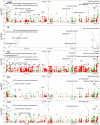Genome-Wide Association Study of Nucleotide Variants Associated with Resistance to Nine Antimicrobials in Mycoplasma bovis
- PMID: 35889084
- PMCID: PMC9320666
- DOI: 10.3390/microorganisms10071366
Genome-Wide Association Study of Nucleotide Variants Associated with Resistance to Nine Antimicrobials in Mycoplasma bovis
Abstract
Antimicrobial resistance (AMR) studies of Mycoplasma bovis have generally focused on specific loci versus using a genome-wide association study (GWAS) approach. A GWAS approach, using two different models, was applied to 194 Mycoplasma bovis genomes. Both a fixed effects linear model (FEM) and a linear mixed model (LMM) identified associations between nucleotide variants (NVs) and antimicrobial susceptibility testing (AST) phenotypes. The AMR phenotypes represented fluoroquinolones, tetracyclines, phenicols, and macrolides. Both models identified known and novel NVs associated (Bonferroni adjusted p < 0.05) with AMR. Fluoroquinolone resistance was associated with multiple NVs, including previously identified mutations in gyrA and parC. NVs in the 30S ribosomal protein 16S were associated with tetracycline resistance, whereas NVs in 5S rRNA, 23S rRNA, and 50S ribosomal proteins were associated with phenicol and macrolide resistance. For all antimicrobial classes, resistance was associated with NVs in genes coding for ABC transporters and other membrane proteins, tRNA-ligases, peptidases, and transposases, suggesting a NV-based multifactorial model of AMR in M. bovis. This study was the largest collection of North American M. bovis isolates used with a GWAS for the sole purpose of identifying novel and non-antimicrobial-target NVs associated with AMR.
Keywords: Mycoplasma bovis; antimicrobial resistance; fluoroquinolone; genome-wide association study; macrolide; phenicol; tetracycline.
Conflict of interest statement
The authors declare that they have no conflicts of interest.
Figures



Similar articles
-
Genome-Wide Association Study Reveals Genetic Markers for Antimicrobial Resistance in Mycoplasma bovis.Microbiol Spectr. 2021 Oct 31;9(2):e0026221. doi: 10.1128/Spectrum.00262-21. Epub 2021 Oct 6. Microbiol Spectr. 2021. PMID: 34612702 Free PMC article.
-
Macrolide and fluoroquinolone associated mutations in Mycoplasma genitalium in a retrospective study of male and female patients seeking care at a STI Clinic in Guangzhou, China, 2016-2018.BMC Infect Dis. 2020 Dec 11;20(1):950. doi: 10.1186/s12879-020-05659-3. BMC Infect Dis. 2020. PMID: 33308173 Free PMC article.
-
Identification of Antimicrobial Resistance-Associated Genes through Whole Genome Sequencing of Mycoplasma bovis Isolates with Different Antimicrobial Resistances.Pathogens. 2020 Jul 19;9(7):588. doi: 10.3390/pathogens9070588. Pathogens. 2020. PMID: 32707642 Free PMC article.
-
Prevalence of mutations associated with resistance to macrolides and fluoroquinolones in Mycoplasma genitalium: a systematic review and meta-analysis.Lancet Infect Dis. 2020 Nov;20(11):1302-1314. doi: 10.1016/S1473-3099(20)30154-7. Epub 2020 Jul 2. Lancet Infect Dis. 2020. PMID: 32622378
-
Mycoplasma bovis: Mechanisms of Resistance and Trends in Antimicrobial Susceptibility.Front Microbiol. 2016 Apr 27;7:595. doi: 10.3389/fmicb.2016.00595. eCollection 2016. Front Microbiol. 2016. PMID: 27199926 Free PMC article. Review.
Cited by
-
Retrospective analysis of antimicrobial resistance associated with bovine respiratory disease.Appl Environ Microbiol. 2025 Mar 19;91(3):e0190924. doi: 10.1128/aem.01909-24. Epub 2025 Feb 7. Appl Environ Microbiol. 2025. PMID: 39918326 Free PMC article.
-
Effect of erythromycin residuals in food on the development of resistance in Streptococcus pneumoniae: an in vivo study in Galleria mellonella.PeerJ. 2024 May 28;12:e17463. doi: 10.7717/peerj.17463. eCollection 2024. PeerJ. 2024. PMID: 38827315 Free PMC article.
-
Genes required for survival and proliferation of Mycoplasma bovis in association with host cells.Appl Environ Microbiol. 2024 Jul 24;90(7):e0068724. doi: 10.1128/aem.00687-24. Epub 2024 Jun 12. Appl Environ Microbiol. 2024. PMID: 38864628 Free PMC article.
-
Phenotypic and genetic insights into efflux pump mechanism in Mycoplasma anserisalpingitidis.Front Microbiol. 2023 Jul 11;14:1216893. doi: 10.3389/fmicb.2023.1216893. eCollection 2023. Front Microbiol. 2023. PMID: 37502405 Free PMC article.
References
Grants and funding
LinkOut - more resources
Full Text Sources

